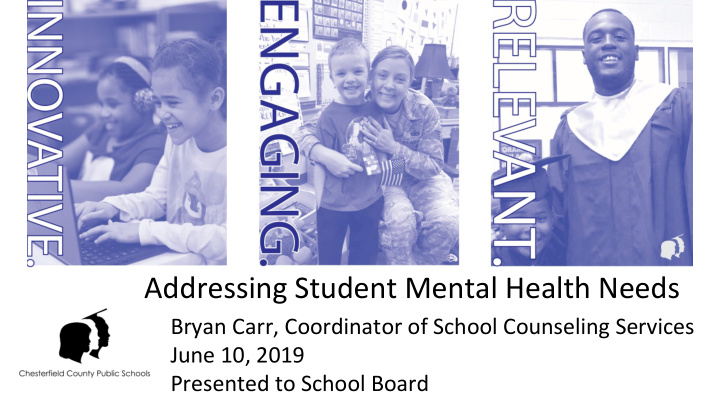



Addressing Student Mental Health Needs Bryan Carr, Coordinator of School Counseling Services June 10, 2019 Presented to School Board
What’s Happening? A significant number of students are…. Living with their own mental health needs ● ● Coping with parents/guardians who have mental health needs Supporting siblings with mental health needs ● ● Experiencing trauma Self harming ● ● Threatening suicide Many of our students are NOT…. ● Focused ● Organized ● Socially involved ● Trusting ● Attending school (truancy and/or suspensions) ● Performing academically to their ability ● Graduating 2
How are we responding? Enlisting the support of our Stakeholders: ● Student Support Services Staff & Administrators Conducting Threat assessments ○ ○ Responding to Gaggle Alerts ○ Facilitating the Direct Admissions process for students to psychiatric hospitals ○ Creating Transition Plans after psychiatric hospitalization Implementing the SOS Program ○ ○ Offering Classroom Lessons (social emotional learning, study/organizational skills, coping strategies) ○ Supporting individual students with identified needs Connecting families to community resources ○ 3
How are we responding? Enlisting the support of our Stakeholders: ● Teachers & Staff Completing the Gatekeepers E-Module training with ○ reinforcement from school student support staff Parents ● ○ Attending “Safeguarding our Youth” parent presentations ● Students ○ Participating in the Signs of Suicide Program, 7th and 10th grade 4
Threat Assessments ● A Threat assessment is a structured group process used to evaluate the risk posed by a student to him-/herself and/or others. ○ Meets the provisions laid out by the state law ○ Involves multiple student support staff to evaluate and support those impacted ● Outcomes: ○ Determine threat level, requires different interventions ○ Identify student needs and offer community resources to families ○ Develop a follow-up support plan to successfully transition back to school 5
Signs of Suicide Program (SOS) SOS: ● Evidence-based mental health program ● Provides tools that help youth identify and report the signs of depression and suicide in themselves and their peers ● Includes a depression screening survey to identify youth at risk (Brief Survey of Adolescent Depression) ● Enables CCPS to meet the state mandate to educate students on recognizing and reporting threats to self and/or others Outcomes: ● Reduce the stigma of mental health ● Linking suicide to mental illness ● Outfit students with a consistent way to report suicide concerns for self or others ● Decrease suicide and suicide attempts 6
Opportunity Costs ● Who? ○ Student Support Service Providers: School Counselors, School Psychologists, School Social Workers, School Nurses ○ School Administration ○ Central Office Leadership - Division Level Mental Health Support Coordinators/Specialists ● How? Impact on professionals’ assigned role ○ ○ Addressing Vicarious Trauma 7
Addressing the Need For the CCPS School Board to consider the 2017 Virginia Board of Education and CCPS School Safety Task Force recommendations to include staffing-level changes in the Standards of Quality for support services staff: ● School psychologists (additional position per 1,000 students) ● School counselors (1 counselor per 250 students) ● Social workers (additional position per 1,000 students) ● Nurses (1 nurse per 550 students). 8
The Future Prevention Identify and implement best practices to support students identified with mental health needs. ● ● Continue to support the expansion of the Signs of Suicide (SOS) program and/or other evidence-based programs. Response ● Offer consultation and support to schools to increase overall best practices in relation to threat assessments and transition plans of students with mental health needs. ● Increase opportunities for identified students to participate in groups and/or intervention activities that facilitate the development of prosocial behaviors and coping strategies. 9
The Future Partnerships ● Continue to enlist community partners to improve communication and streamline mental health intake, assessment and discharge processes. ● Explore the opportunities for physical and mental health partnerships in schools . Planning ● Incorporate mental health wellness standards into the CCPS health and wellness curriculum. ● Adopt a common anonymous reporting system in each school. 10
The Charge “Equity is the practice of providing every student, according to strengths and needs, exactly what they need so they are able to learn , experience success and thrive .”
Addressing Student Mental Health Needs Bryan Carr, Coordinator of School Counseling Services June 10, 2019 Presented to School Board
Recommend
More recommend